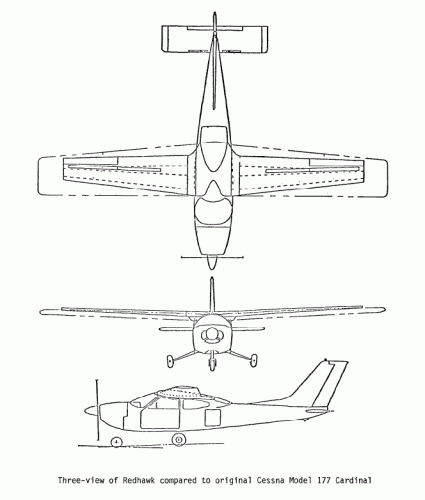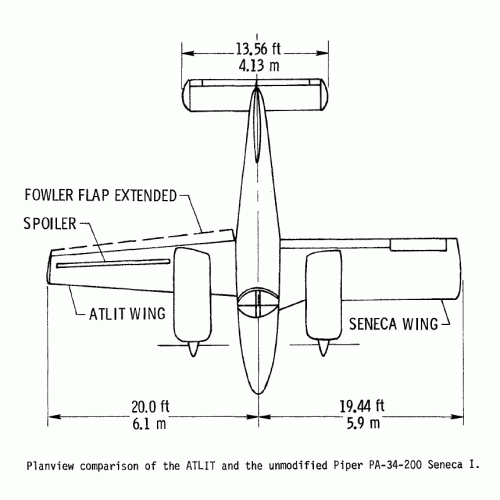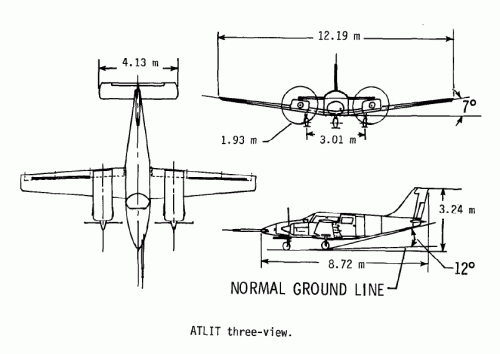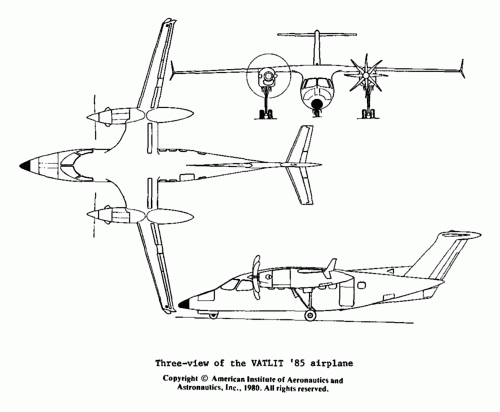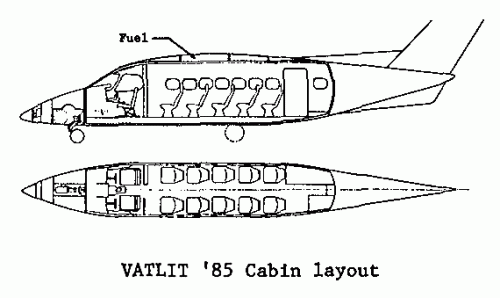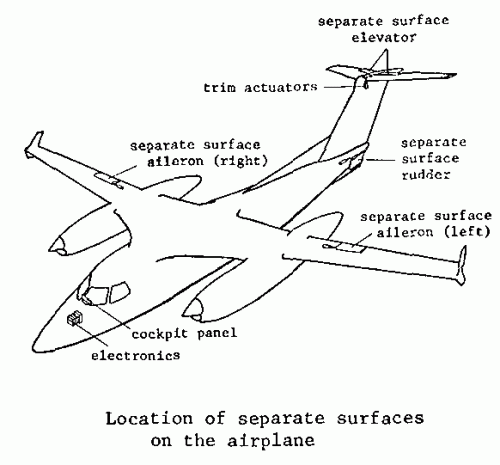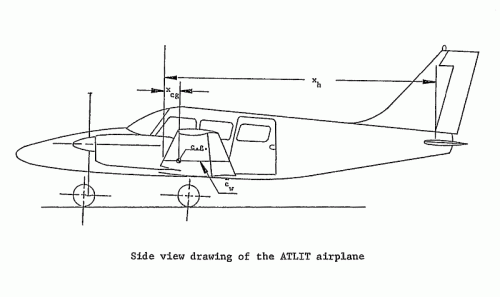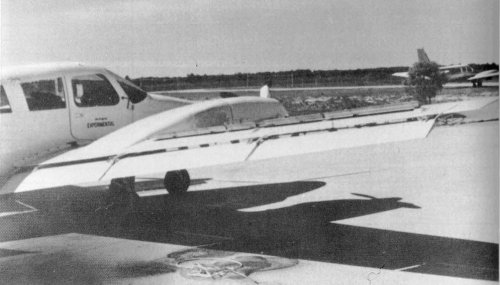- Joined
- 25 June 2009
- Messages
- 14,753
- Reaction score
- 6,151
From October 1974 to June 1976, the University of Kansas (KU) led a series of tests on the ATLIT (Advanced Technology Light Twin) modified Piper PA-34-200 Seneca I modified by the installation of new wings incorporating the GA(W)-1 (Whitcomb) airfoil, reduced wing area, roll-control spoilers, and full-span Fowler flaps.
The ATLIT itself was the second airplane designed and constructed as part of a general aviation research program at the KU Flight Research Laboratory (FRL), sponsored by grants from NASA's Langley Research Center (LaRC). A twin engine Piper Seneca was donated to the program by Piper Aircraft and a modified wing (built by Cessna Aircraft) was built. The airplane which preceded ATLIT in development was the Redhawk, a modified Cessna Cardinal developed in conjunction with NASA and Cessna. The object of the research under these grants was to apply existing jet-transport wing technology and advanced airfoil technology to general aviation airplanes for the purpose of improving safety, efficiency, and utility.
The ATLIT program resulted in the 1980 VATLIT (Very Advanced Technology Light Twin) 1985 study (often abbreviated as VATLIT '85), under the supervision of Dr. Jan Roskam, and in collaboration with Piper Aircraft and NASA. This was a preliminary design of a light, twin-engine airplane for stage distances up to 2500 nautical miles, and was based on the FAA airworthiness requirements in the transport category (FAR, Part 25). The design aim was to study feasibility of an executive turboprop twin of 5670 kg (12,500 lb) maximum takeoff weight with performance comparable to that of a jet airplane, combined with the fuel efficiency of a turboprop. Improvements were found in the areas of aerodynamics, propulsion, structures and production methods and are incorporated in the preliminary design.
A high aspect ratio wing with a relatively high wing loading, supercritical airfoil sections that generate a high lift-to-drag ratio and winglets were included to improve lifting surface characteristics. A separate surface stability augmentation system was introduced into this design to improve the stability and control of the airplane at reasonable cost and weight without the redundancy penalties usually associated with such systems. Advanced structures and material properties
(boron and carbon laminates) were incorporated to keep the empty weight down. New production methods (metal bonding, synthetic material and
foam techniques) were considered. A study was made of the application of the propfan concept to obtain a high efficiency at high cruise Mach number
(.7) which would result in improved fuel efficiency.
The VATLIT design itself was not built, but the program was instrumental in the design of the Piaggio Avanti and was followed up by NASA's AGATE program.
More information on these programs:
The ATLIT itself was the second airplane designed and constructed as part of a general aviation research program at the KU Flight Research Laboratory (FRL), sponsored by grants from NASA's Langley Research Center (LaRC). A twin engine Piper Seneca was donated to the program by Piper Aircraft and a modified wing (built by Cessna Aircraft) was built. The airplane which preceded ATLIT in development was the Redhawk, a modified Cessna Cardinal developed in conjunction with NASA and Cessna. The object of the research under these grants was to apply existing jet-transport wing technology and advanced airfoil technology to general aviation airplanes for the purpose of improving safety, efficiency, and utility.
The ATLIT program resulted in the 1980 VATLIT (Very Advanced Technology Light Twin) 1985 study (often abbreviated as VATLIT '85), under the supervision of Dr. Jan Roskam, and in collaboration with Piper Aircraft and NASA. This was a preliminary design of a light, twin-engine airplane for stage distances up to 2500 nautical miles, and was based on the FAA airworthiness requirements in the transport category (FAR, Part 25). The design aim was to study feasibility of an executive turboprop twin of 5670 kg (12,500 lb) maximum takeoff weight with performance comparable to that of a jet airplane, combined with the fuel efficiency of a turboprop. Improvements were found in the areas of aerodynamics, propulsion, structures and production methods and are incorporated in the preliminary design.
A high aspect ratio wing with a relatively high wing loading, supercritical airfoil sections that generate a high lift-to-drag ratio and winglets were included to improve lifting surface characteristics. A separate surface stability augmentation system was introduced into this design to improve the stability and control of the airplane at reasonable cost and weight without the redundancy penalties usually associated with such systems. Advanced structures and material properties
(boron and carbon laminates) were incorporated to keep the empty weight down. New production methods (metal bonding, synthetic material and
foam techniques) were considered. A study was made of the application of the propfan concept to obtain a high efficiency at high cruise Mach number
(.7) which would result in improved fuel efficiency.
The VATLIT design itself was not built, but the program was instrumental in the design of the Piaggio Avanti and was followed up by NASA's AGATE program.
More information on these programs:
- [NASA CR-2832] Flight Evaluation of an Advanced Technology Light Twin-Engine Airplane (ATLIT) (July 1977)
https://archive.org/details/nasa_techdoc_19770026160 - [NASA-CR-158753] Comparison of Theoretical Predicted Longitudinal Aerodynamic Characteristics with Full-Scale Wind-Tunnel Data on the ATLIT Airplane (July 1979)
http://ntrs.nasa.gov/archive/nasa/casi.ntrs.nasa.gov/19790017847.pdf - [AIAA-80-1862] Preliminary Design of a Very Advanced Technology Light Twin for the Mid-80’s (August 1980)
http://www.grosveld.com/publications/1980_1862.pdf - Roskam's Airplane War Stories: An Account of the Professional Life and Work
http://books.google.com/books?id=rBksUk40jlEC
- Fliegende Chefetage by Rolf Wurster (pages 62 & 63)
http://books.google.com/books?id=-j81W3LWXekC&pg=PA62
- Tekhnicheskaya Informatsiya No.16 (1981)
http://civilavia.info/files/cagi/c-013.zip

